Historical Fiction E-books
47 titles sorted by popularity
-
 The Count of Monte Cristo Alexandre DumasThe Count of Monte Cristo is an adventure novel by French author Alexandre Dumas . Completed in 1844, it is one of the author’s most popular works, along with The Three Musketeers and is considered as one of the best novels ever written. Like many of his novels, it is expanded from plot outlines suggested by his collaborating ghostwriter Auguste Maquet.
The Count of Monte Cristo Alexandre DumasThe Count of Monte Cristo is an adventure novel by French author Alexandre Dumas . Completed in 1844, it is one of the author’s most popular works, along with The Three Musketeers and is considered as one of the best novels ever written. Like many of his novels, it is expanded from plot outlines suggested by his collaborating ghostwriter Auguste Maquet.
-
 Les Misérables Victor HugoThe classic novel–and hit Broadway show–about escaped convict Jean Valjean has been adapted with easy-to-read text, large type, and short chapters. This engaging adaptation of the timeless tale is ideal for reluctant readers and kids not yet ready to tackle the original. From the Trade Paperback edition.
Les Misérables Victor HugoThe classic novel–and hit Broadway show–about escaped convict Jean Valjean has been adapted with easy-to-read text, large type, and short chapters. This engaging adaptation of the timeless tale is ideal for reluctant readers and kids not yet ready to tackle the original. From the Trade Paperback edition.
-
 The Picture of Dorian Gray Oscar WildeThe Picture of Dorian Gray is the only published novel by Oscar Wilde, appearing as the lead story in Lippincott’s Monthly Magazine on 20 June 1890, printed as the July 1890 issue of this magazine. The magazine’s editors feared the story was indecent as submitted, so they censored roughly 500 words, without Wilde’s knowledge, before publication. But even with that, the story was still greeted with outrage by British reviewers, some of whom suggested that Wilde should be prosecuted on moral grounds, leading Wilde to defend the novel aggressively in letters to the British press. Wilde later revised the story for book publication, making substantial alterations, deleting controversial passages, adding new chapters and including an aphoristic Preface which has since become famous in its own right. The amended version was published by Ward, Lock and Company in April 1891. Some scholars believe that Wilde would today have wanted us to read the version he originally submitted to Lippincott’s.
The Picture of Dorian Gray Oscar WildeThe Picture of Dorian Gray is the only published novel by Oscar Wilde, appearing as the lead story in Lippincott’s Monthly Magazine on 20 June 1890, printed as the July 1890 issue of this magazine. The magazine’s editors feared the story was indecent as submitted, so they censored roughly 500 words, without Wilde’s knowledge, before publication. But even with that, the story was still greeted with outrage by British reviewers, some of whom suggested that Wilde should be prosecuted on moral grounds, leading Wilde to defend the novel aggressively in letters to the British press. Wilde later revised the story for book publication, making substantial alterations, deleting controversial passages, adding new chapters and including an aphoristic Preface which has since become famous in its own right. The amended version was published by Ward, Lock and Company in April 1891. Some scholars believe that Wilde would today have wanted us to read the version he originally submitted to Lippincott’s.
-
 A Tale of Two Cities Charles DickensA Tale of Two Cities is a novel by Charles Dickens, set in London and Paris before and during the French Revolution. With well over 200 million copies sold, it ranks among the most famous works in the history of fictional literature.
A Tale of Two Cities Charles DickensA Tale of Two Cities is a novel by Charles Dickens, set in London and Paris before and during the French Revolution. With well over 200 million copies sold, it ranks among the most famous works in the history of fictional literature.
-
 The Three Musketeers Alexandre DumasThe Three Musketeers is a novel by Alexandre Dumas, first serialized in March–July 1844. Set in the 17th century, it recounts the adventures of a young man named d’Artagnan after he leaves home to travel to Paris, to join the Musketeers of the Guard. D’Artagnan is not one of the musketeers of the title; those are his friends Athos, Porthos and Aramis, inseparable friends who live by the motto “all for one, one for all” , a motto which is first put forth by d’Artagnan.
The Three Musketeers Alexandre DumasThe Three Musketeers is a novel by Alexandre Dumas, first serialized in March–July 1844. Set in the 17th century, it recounts the adventures of a young man named d’Artagnan after he leaves home to travel to Paris, to join the Musketeers of the Guard. D’Artagnan is not one of the musketeers of the title; those are his friends Athos, Porthos and Aramis, inseparable friends who live by the motto “all for one, one for all” , a motto which is first put forth by d’Artagnan.
-
 War and Peace Leo TolstoyWar and Peace is a novel by the Russian author Leo Tolstoy, first published in 1869. The work is epic in scale and is regarded as one of the most important works of world literature. It is considered Tolstoy’s finest literary achievement, along with his other major prose work Anna Karenina .
War and Peace Leo TolstoyWar and Peace is a novel by the Russian author Leo Tolstoy, first published in 1869. The work is epic in scale and is regarded as one of the most important works of world literature. It is considered Tolstoy’s finest literary achievement, along with his other major prose work Anna Karenina .
-
 Notes from the Underground Fyodor DostoyevskyNotes from Underground is an 1864 novella by Fyodor Dostoyevsky. Notes is considered by many to be the first existentialist novel. It presents itself as an excerpt from the rambling memoirs of a bitter, isolated, unnamed narrator who is a retired civil servant living in St. Petersburg.
Notes from the Underground Fyodor DostoyevskyNotes from Underground is an 1864 novella by Fyodor Dostoyevsky. Notes is considered by many to be the first existentialist novel. It presents itself as an excerpt from the rambling memoirs of a bitter, isolated, unnamed narrator who is a retired civil servant living in St. Petersburg.
-
 Heidi Johanna SpyriHeidi is a Swiss work of fiction, originally published in two parts as Heidi’s years of learning and travel and Heidi makes use of what she has learned. It is a novel about the events in the life of a young girl in her grandfather’s care, in the Swiss Alps. It was written as a book “for children and those who love children” in 1880 by Swiss author Johanna Spyri.
Heidi Johanna SpyriHeidi is a Swiss work of fiction, originally published in two parts as Heidi’s years of learning and travel and Heidi makes use of what she has learned. It is a novel about the events in the life of a young girl in her grandfather’s care, in the Swiss Alps. It was written as a book “for children and those who love children” in 1880 by Swiss author Johanna Spyri.
-
 Anne of Green Gables L. M. MontgomeryAnne of Green Gables is a bestselling 1908 novel by Canadian author Lucy Maud Montgomery. Written as fiction for readers of all ages, the literary classic has been considered a children’s novel since the mid-twentieth century. It recounts the adventures of Anne Shirley, a young orphan girl mistakenly sent to Matthew and Marilla Cuthbert, a middle-aged brother and sister who have a farm on Prince Edward Island and who had intended to adopt a boy to help them. The novel recounts how Anne makes her way with the Cuthberts, in school and within the town.
Anne of Green Gables L. M. MontgomeryAnne of Green Gables is a bestselling 1908 novel by Canadian author Lucy Maud Montgomery. Written as fiction for readers of all ages, the literary classic has been considered a children’s novel since the mid-twentieth century. It recounts the adventures of Anne Shirley, a young orphan girl mistakenly sent to Matthew and Marilla Cuthbert, a middle-aged brother and sister who have a farm on Prince Edward Island and who had intended to adopt a boy to help them. The novel recounts how Anne makes her way with the Cuthberts, in school and within the town.
-
 Uncle Tom’s Cabin Harriet Beecher StoweUncle Tom’s Cabin; or, Life Among the Lowly is an anti-slavery novel by American author Harriet Beecher Stowe. Published in 1852, the novel “helped lay the groundwork for the Civil War”, according to Will Kaufman.
Uncle Tom’s Cabin Harriet Beecher StoweUncle Tom’s Cabin; or, Life Among the Lowly is an anti-slavery novel by American author Harriet Beecher Stowe. Published in 1852, the novel “helped lay the groundwork for the Civil War”, according to Will Kaufman.
-
 The Man in the Iron Mask Alexandre DumasThe Man in the Iron Mask is a name given to a prisoner arrested as Eustache Dauger in 1669 or 1670, and held in a number of jails, including the Bastille and the Fortress of Pignerol . He was held in the custody of the same jailer, Bénigne Dauvergne de Saint-Mars, for a period of 34 years. He died on 19 November 1703 under the name of Marchioly, during the reign of Louis XIV of France . The possible identity of this man has been thoroughly discussed and has been the subject of many books, because no one ever saw his face, which was hidden by a mask of black velvet cloth.
The Man in the Iron Mask Alexandre DumasThe Man in the Iron Mask is a name given to a prisoner arrested as Eustache Dauger in 1669 or 1670, and held in a number of jails, including the Bastille and the Fortress of Pignerol . He was held in the custody of the same jailer, Bénigne Dauvergne de Saint-Mars, for a period of 34 years. He died on 19 November 1703 under the name of Marchioly, during the reign of Louis XIV of France . The possible identity of this man has been thoroughly discussed and has been the subject of many books, because no one ever saw his face, which was hidden by a mask of black velvet cloth.
-
 The Prince and the Pauper Mark TwainThe Prince and the Pauper is a novel by American author Mark Twain. It was first published in 1881 in Canada, before its 1882 publication in the United States. The novel represents Twain’s first attempt at historical fiction. Set in 1547, it tells the story of two young boys who are identical in appearance: Tom Canty, a pauper who lives with his abusive father in Offal Court off Pudding Lane in London, and Prince Edward, son of King Henry VIII.
The Prince and the Pauper Mark TwainThe Prince and the Pauper is a novel by American author Mark Twain. It was first published in 1881 in Canada, before its 1882 publication in the United States. The novel represents Twain’s first attempt at historical fiction. Set in 1547, it tells the story of two young boys who are identical in appearance: Tom Canty, a pauper who lives with his abusive father in Offal Court off Pudding Lane in London, and Prince Edward, son of King Henry VIII.
-
 The Jungle Upton SinclairThe Jungle is a 1906 novel written by the American journalist and novelist Upton Sinclair . Sinclair wrote the novel to portray the lives of immigrants in the United States. Many readers were most concerned with his exposure of practices in the American meatpacking industry during the early 20th century, based on an investigation he did for a socialist newspaper.
The Jungle Upton SinclairThe Jungle is a 1906 novel written by the American journalist and novelist Upton Sinclair . Sinclair wrote the novel to portray the lives of immigrants in the United States. Many readers were most concerned with his exposure of practices in the American meatpacking industry during the early 20th century, based on an investigation he did for a socialist newspaper.
-
 The Scarlet Letter Nathaniel HawthorneThe Scarlet Letter is an 1850 romantic work of fiction in a historical setting, written by Nathaniel Hawthorne. It is considered to be his magnum opus. Set in 17th-century Puritan Salem, Massachusetts during the years 1642 to 1649, it tells the story of Hester Prynne, who conceives a daughter through an adulterous affair and struggles to create a new life of repentance and dignity. Throughout the book, Hawthorne explores themes of legalism, sin, and guilt.
The Scarlet Letter Nathaniel HawthorneThe Scarlet Letter is an 1850 romantic work of fiction in a historical setting, written by Nathaniel Hawthorne. It is considered to be his magnum opus. Set in 17th-century Puritan Salem, Massachusetts during the years 1642 to 1649, it tells the story of Hester Prynne, who conceives a daughter through an adulterous affair and struggles to create a new life of repentance and dignity. Throughout the book, Hawthorne explores themes of legalism, sin, and guilt.
-
 The Lost World Arthur Conan DoyleSir Arthur Conan Doyle’s The Lost World is a syndicated television series loosely based on the 1912 novel by Sir Arthur Conan Doyle, The Lost World. Premiered in the fall of 1999 , it ran for three seasons before it was cancelled on a cliffhanger in 2002 after funding for a fourth season fell through. To date, the cliffhanger remains unresolved. All three seasons were released in DVD box sets through 2004. The series continued to be rerun in the United States on TNT at 5:00AM EST Monday through Friday, until eventually that came to an end as well.
The Lost World Arthur Conan DoyleSir Arthur Conan Doyle’s The Lost World is a syndicated television series loosely based on the 1912 novel by Sir Arthur Conan Doyle, The Lost World. Premiered in the fall of 1999 , it ran for three seasons before it was cancelled on a cliffhanger in 2002 after funding for a fourth season fell through. To date, the cliffhanger remains unresolved. All three seasons were released in DVD box sets through 2004. The series continued to be rerun in the United States on TNT at 5:00AM EST Monday through Friday, until eventually that came to an end as well.
-
 Kidnapped Robert Louis StevensonKidnapped is a historical fiction adventure novel by the Scottish author Robert Louis Stevenson. Written as a “boys’ novel” and first published in the magazine Young Folks from May to July 1886, the novel has attracted the praise and admiration of writers as diverse as Henry James, Jorge Luis Borges, and Seamus Heaney. A sequel, Catriona, was published in 1893.
Kidnapped Robert Louis StevensonKidnapped is a historical fiction adventure novel by the Scottish author Robert Louis Stevenson. Written as a “boys’ novel” and first published in the magazine Young Folks from May to July 1886, the novel has attracted the praise and admiration of writers as diverse as Henry James, Jorge Luis Borges, and Seamus Heaney. A sequel, Catriona, was published in 1893.
-
 The Last of the Mohicans; A narrative of 1757 James Fenimore CooperThe Last of the Mohicans: A Narrative of 1757 is a historical novel by James Fenimore Cooper. It is the second book of the Leatherstocking Tales pentalogy and the best known. The Pathfinder, published 14 years later in 1840, is its sequel.
The Last of the Mohicans; A narrative of 1757 James Fenimore CooperThe Last of the Mohicans: A Narrative of 1757 is a historical novel by James Fenimore Cooper. It is the second book of the Leatherstocking Tales pentalogy and the best known. The Pathfinder, published 14 years later in 1840, is its sequel.
-
 Little Men Louisa May AlcottLittle Men, or Life at Plumfield with Jo’s Boys is a novel by American author Louisa May Alcott, first published in 1871. The novel reprises characters from Little Women and is considered by some the second book of an unofficial Little Women trilogy, which is completed with Alcott’s 1886 novel Jo’s Boys, and How They Turned Out: A Sequel to “Little Men”. Little Men tells the story of Jo Bhaer and the children at Plumfield Estate School. The book was inspired by the death of Alcott’s brother-in-law, which reveals itself in one of the last chapters, when a beloved character from Little Women passes away. The novel has been adapted to a 1934 film, a 1940 film, a television series, and a Japanese animated television series.
Little Men Louisa May AlcottLittle Men, or Life at Plumfield with Jo’s Boys is a novel by American author Louisa May Alcott, first published in 1871. The novel reprises characters from Little Women and is considered by some the second book of an unofficial Little Women trilogy, which is completed with Alcott’s 1886 novel Jo’s Boys, and How They Turned Out: A Sequel to “Little Men”. Little Men tells the story of Jo Bhaer and the children at Plumfield Estate School. The book was inspired by the death of Alcott’s brother-in-law, which reveals itself in one of the last chapters, when a beloved character from Little Women passes away. The novel has been adapted to a 1934 film, a 1940 film, a television series, and a Japanese animated television series.
-
 The Decameron of Giovanni Boccaccio Giovanni BoccaccioIn the summer of 1348, with the plague ravaging Florence, ten young men and women take refuge in the countryside, where they entertain themselves with tales of love, death, and corruption, featuring a host of characters, from lascivious clergymen and mad kings to devious lovers and false miracle-makers. Named after the Greek for “ten days,†Boccaccio’s book of stories draws on ancient mythology, contemporary history, and everyday life, and has influenced the work of myriad writers who came after him. J. G. Nichols’s new translation, faithful to the original but rendered in eminently readable modern English, captures the timeless humor of one of the great classics of European literature. A brilliant new translation of the work that Herman Hesse called “the first great masterpiece of European storytelling.†From the Hardcover edition.
The Decameron of Giovanni Boccaccio Giovanni BoccaccioIn the summer of 1348, with the plague ravaging Florence, ten young men and women take refuge in the countryside, where they entertain themselves with tales of love, death, and corruption, featuring a host of characters, from lascivious clergymen and mad kings to devious lovers and false miracle-makers. Named after the Greek for “ten days,†Boccaccio’s book of stories draws on ancient mythology, contemporary history, and everyday life, and has influenced the work of myriad writers who came after him. J. G. Nichols’s new translation, faithful to the original but rendered in eminently readable modern English, captures the timeless humor of one of the great classics of European literature. A brilliant new translation of the work that Herman Hesse called “the first great masterpiece of European storytelling.†From the Hardcover edition.
-
 Captain Blood Rafael SabatiniPeter Blood, an Irish physician and soldier in England in the 1680’s, is wrongly convicted of treason and sentenced to indentured slavery in the Caribbean. He escapes and becomes the most feared pirate captain on the Spanish Main, but all the glory of his adventures cannot help him, for the woman he loves cannot love a “thief and pirate.”
Captain Blood Rafael SabatiniPeter Blood, an Irish physician and soldier in England in the 1680’s, is wrongly convicted of treason and sentenced to indentured slavery in the Caribbean. He escapes and becomes the most feared pirate captain on the Spanish Main, but all the glory of his adventures cannot help him, for the woman he loves cannot love a “thief and pirate.”
-
 Twenty Years After Alexandre DumasTwenty Years After is a novel by Alexandre Dumas, père, first serialized from January to August, 1845. A book of the D’Artagnan Romances, it is a sequel to The Three Musketeers and precedes The Vicomte de Bragelonne .
Twenty Years After Alexandre DumasTwenty Years After is a novel by Alexandre Dumas, père, first serialized from January to August, 1845. A book of the D’Artagnan Romances, it is a sequel to The Three Musketeers and precedes The Vicomte de Bragelonne .
-
 An Occurrence at Owl Creek Bridge Ambrose Bierce“An Occurrence at Owl Creek Bridge” or “A Dead Mans Dream” is a short story by American author Ambrose Bierce . Originally published by the The San Francisco Examiner in 1890, it was first collected in Bierce’s 1891 book Tales of Soldiers and Civilians. The story, which is set during the Civil War, is famous for its irregular time sequence and twist ending. It is Bierce’s most anthologized story.
An Occurrence at Owl Creek Bridge Ambrose Bierce“An Occurrence at Owl Creek Bridge” or “A Dead Mans Dream” is a short story by American author Ambrose Bierce . Originally published by the The San Francisco Examiner in 1890, it was first collected in Bierce’s 1891 book Tales of Soldiers and Civilians. The story, which is set during the Civil War, is famous for its irregular time sequence and twist ending. It is Bierce’s most anthologized story.
-
 Eve’s Diary, Complete Mark TwainEve’s Diary is a comic short story by Mark Twain. It was first published in the 1905 Christmas issue of the magazine Harper’s Bazaar, and in book format in June 1906 by Harper and Brothers publishing house. It is written in the style of a diary kept by the first woman in the Judeo-Christian creation story, Eve, and is claimed to be “translated from the original MS.” The “plot” of this novel is the first-person account of Eve from her creation up to her burial by, her mate, Adam, including meeting and getting to know Adam, and exploring the world around her, Eden. The story then jumps 40 years into the future after the Fall and expulsion from Eden. It is one of a series of books Twain wrote concerning the story of Adam and Eve, including ‘Extracts from Adam’s Diary,’ ‘That Day In Eden,’ ‘Eve Speaks,’ ‘Adam’s Soliloquy,’ and the ‘Autobiography of Eve.’ Eve’s Diary has a lighter tone than the others in the series, as Eve has a strong appreciation for beauty and love. The book may have been written as a posthumous love-letter to Mark Twain’s wife Olivia Langdon Clemens, or Livy, who died in June 1904, just before the story was written. Mark Twain is quoted as saying, “Eve’s Diary is finished — I’ve been waiting for her to speak, but she doesn’t say anything more.” The story ends with Adam’s speaking at Eve’s grave, “Wherever she was, there was Eden.”
Eve’s Diary, Complete Mark TwainEve’s Diary is a comic short story by Mark Twain. It was first published in the 1905 Christmas issue of the magazine Harper’s Bazaar, and in book format in June 1906 by Harper and Brothers publishing house. It is written in the style of a diary kept by the first woman in the Judeo-Christian creation story, Eve, and is claimed to be “translated from the original MS.” The “plot” of this novel is the first-person account of Eve from her creation up to her burial by, her mate, Adam, including meeting and getting to know Adam, and exploring the world around her, Eden. The story then jumps 40 years into the future after the Fall and expulsion from Eden. It is one of a series of books Twain wrote concerning the story of Adam and Eve, including ‘Extracts from Adam’s Diary,’ ‘That Day In Eden,’ ‘Eve Speaks,’ ‘Adam’s Soliloquy,’ and the ‘Autobiography of Eve.’ Eve’s Diary has a lighter tone than the others in the series, as Eve has a strong appreciation for beauty and love. The book may have been written as a posthumous love-letter to Mark Twain’s wife Olivia Langdon Clemens, or Livy, who died in June 1904, just before the story was written. Mark Twain is quoted as saying, “Eve’s Diary is finished — I’ve been waiting for her to speak, but she doesn’t say anything more.” The story ends with Adam’s speaking at Eve’s grave, “Wherever she was, there was Eden.”
-
 The Social Cancer: A Complete English Version of Noli Me Tangere José RizalThe Social Cancer is the English translation of a novel written by José Rizal, the national hero of the Philippines, during the colonization of the country by Spain to expose the inequities of the Spanish Catholic priests and the ruling government. The original title, “Noli Me Tángere” is in Latin meaning Touch me not, refers to John 20:17 in the Bible as Mary Magdalene tried to touch the newly risen Jesus, He said “Touch me not; for I am not yet ascended to my Father.”
The Social Cancer: A Complete English Version of Noli Me Tangere José RizalThe Social Cancer is the English translation of a novel written by José Rizal, the national hero of the Philippines, during the colonization of the country by Spain to expose the inequities of the Spanish Catholic priests and the ruling government. The original title, “Noli Me Tángere” is in Latin meaning Touch me not, refers to John 20:17 in the Bible as Mary Magdalene tried to touch the newly risen Jesus, He said “Touch me not; for I am not yet ascended to my Father.”
-
 Hard Times Charles DickensHard Times – For These Times is the tenth novel by Charles Dickens, first published in 1854. The book appraises English society and is aimed at highlighting the social and economic pressures of the times.
Hard Times Charles DickensHard Times – For These Times is the tenth novel by Charles Dickens, first published in 1854. The book appraises English society and is aimed at highlighting the social and economic pressures of the times.
-
 Anne of Avonlea L. M. MontgomeryAnne of Avonlea is a novel by Lucy Maud Montgomery. It was first published in 1909.
Anne of Avonlea L. M. MontgomeryAnne of Avonlea is a novel by Lucy Maud Montgomery. It was first published in 1909.
-
 Nostromo, a Tale of the Seaboard Joseph ConradNostromo is a 1904 novel by Polish novelist Joseph Conrad, set in the fictitious South American republic of “Costaguana”. It was originally published serially in two volumes of T.P.’s Weekly.
Nostromo, a Tale of the Seaboard Joseph ConradNostromo is a 1904 novel by Polish novelist Joseph Conrad, set in the fictitious South American republic of “Costaguana”. It was originally published serially in two volumes of T.P.’s Weekly.
-
 Little Lord Fauntleroy Frances Hodgson BurnettLittle Lord Fauntleroy is the first children’s novel written by English playwright and author Frances Hodgson Burnett. It was originally published as a serial in the St. Nicholas Magazine between November 1885 and October 1886, then as a book by Scribner’s in 1886. The accompanying illustrations by Reginald Birch set fashion trends and Little Lord Fauntleroy also set a precedent in copyright law when in 1888 its author won a lawsuit against E. V. Seebohm over the rights to theatrical adaptations of the work.
Little Lord Fauntleroy Frances Hodgson BurnettLittle Lord Fauntleroy is the first children’s novel written by English playwright and author Frances Hodgson Burnett. It was originally published as a serial in the St. Nicholas Magazine between November 1885 and October 1886, then as a book by Scribner’s in 1886. The accompanying illustrations by Reginald Birch set fashion trends and Little Lord Fauntleroy also set a precedent in copyright law when in 1888 its author won a lawsuit against E. V. Seebohm over the rights to theatrical adaptations of the work.
-
 House of the Seven Gables Nathaniel HawthorneThe House of the Seven Gables is a Gothic novel written beginning in mid-1850 by American author Nathaniel Hawthorne and published in April 1851 by Ticknor and Fields of Boston. The novel follows a New England family and their ancestral home. In the book, Hawthorne explores themes of guilt, retribution, and atonement and colors the tale with suggestions of the supernatural and witchcraft. The setting for the book was inspired by a gabled house in Salem belonging to Hawthorne’s cousin Susanna Ingersoll and by ancestors of Hawthorne who had played a part in the Salem Witch Trials of 1692. The book was well received upon publication and later had a strong influence on the work of H. P. Lovecraft. The House of the Seven Gables has been adapted several times to film and television.
House of the Seven Gables Nathaniel HawthorneThe House of the Seven Gables is a Gothic novel written beginning in mid-1850 by American author Nathaniel Hawthorne and published in April 1851 by Ticknor and Fields of Boston. The novel follows a New England family and their ancestral home. In the book, Hawthorne explores themes of guilt, retribution, and atonement and colors the tale with suggestions of the supernatural and witchcraft. The setting for the book was inspired by a gabled house in Salem belonging to Hawthorne’s cousin Susanna Ingersoll and by ancestors of Hawthorne who had played a part in the Salem Witch Trials of 1692. The book was well received upon publication and later had a strong influence on the work of H. P. Lovecraft. The House of the Seven Gables has been adapted several times to film and television.
-
 The Man Who Would Be King Rudyard Kipling“The Man Who Would Be King” is a novella by Rudyard Kipling. It is about two British adventurers in British India who become kings of Kafiristan, a remote part of Afghanistan. The story was inspired by the exploits of James Brooke, an Englishman who became the first White Rajah of Sarawak in Borneo; and by the travels of American adventurer Josiah Harlan, who was granted the title Prince of Ghor in perpetuity for himself and his descendants. It incorporates a number of other factual elements such as the European-like appearance of many Nuristani people, and an ending modelled on the return of the head of the explorer Adolf Schlagintweit to colonial administrators.
The Man Who Would Be King Rudyard Kipling“The Man Who Would Be King” is a novella by Rudyard Kipling. It is about two British adventurers in British India who become kings of Kafiristan, a remote part of Afghanistan. The story was inspired by the exploits of James Brooke, an Englishman who became the first White Rajah of Sarawak in Borneo; and by the travels of American adventurer Josiah Harlan, who was granted the title Prince of Ghor in perpetuity for himself and his descendants. It incorporates a number of other factual elements such as the European-like appearance of many Nuristani people, and an ending modelled on the return of the head of the explorer Adolf Schlagintweit to colonial administrators.
-
 The Reign of Greed José RizalEl Filibusterismo , also known by its English alternate title The Reign of Greed, is the second novel written by Philippine national hero José Rizal. It is the sequel to Noli Me Tángere and, like the first book, was written in Spanish. It was first published in 1891 in Ghent, Belgium.
The Reign of Greed José RizalEl Filibusterismo , also known by its English alternate title The Reign of Greed, is the second novel written by Philippine national hero José Rizal. It is the sequel to Noli Me Tángere and, like the first book, was written in Spanish. It was first published in 1891 in Ghent, Belgium.
-
 The Red Badge of Courage Stephen CraneThe Red Badge of Courage is a war novel by American author Stephen Crane . Taking place during the American Civil War, the story is about a young private of the Union Army, Henry Fleming, who flees from the field of battle. Overcome with shame, he longs for a wound—a “red badge of courage”—to counteract his cowardice. When his regiment once again faces the enemy, Henry acts as standard-bearer.
The Red Badge of Courage Stephen CraneThe Red Badge of Courage is a war novel by American author Stephen Crane . Taking place during the American Civil War, the story is about a young private of the Union Army, Henry Fleming, who flees from the field of battle. Overcome with shame, he longs for a wound—a “red badge of courage”—to counteract his cowardice. When his regiment once again faces the enemy, Henry acts as standard-bearer.
-
 The Ragged Trousered Philanthropists Robert TressellThe Ragged-Trousered Philanthropists is a novel by Robert Tressell first published in 1914 after his death in 1911. An explicitly political work, it is widely regarded as a classic of working-class literature.
The Ragged Trousered Philanthropists Robert TressellThe Ragged-Trousered Philanthropists is a novel by Robert Tressell first published in 1914 after his death in 1911. An explicitly political work, it is widely regarded as a classic of working-class literature.
-
 The Secret Agent Joseph ConradThe Secret Agent: A Simple Tale is a novel by Joseph Conrad published in 1907. The story is set in London in 1886 and deals largely with the life of Mr. Verloc and his job as a spy. The Secret Agent is also notable as it is one of Conrad’s later political novels, which move away from his typical tales of seafaring. The novel deals broadly with the notions of anarchism, espionage, and terrorism. It portrays anarchist or revolutionary groups before many of the social uprisings of the twentieth century. However, it also deals with exploitation, particularly with regard to Verloc’s relationship with his brother-in-law Stevie.
The Secret Agent Joseph ConradThe Secret Agent: A Simple Tale is a novel by Joseph Conrad published in 1907. The story is set in London in 1886 and deals largely with the life of Mr. Verloc and his job as a spy. The Secret Agent is also notable as it is one of Conrad’s later political novels, which move away from his typical tales of seafaring. The novel deals broadly with the notions of anarchism, espionage, and terrorism. It portrays anarchist or revolutionary groups before many of the social uprisings of the twentieth century. However, it also deals with exploitation, particularly with regard to Verloc’s relationship with his brother-in-law Stevie.
-
 The Deerslayer James Fenimore CooperThe Deerslayer, or The First Warpath was the last of James Fenimore Cooper’s Leatherstocking tales to be written. Its 1740-1745 time period makes it the first installment chronologically and in the lifetime of the hero of the Leatherstocking tales, Natty Bumppo. The novel’s setting on Otsego Lake in central, upstate New York, is the same as that of The Pioneers, the first of the Leatherstocking tales to be published . The Deerslayer is considered to be the prequel to the rest of the Leatherstocking tales. Fenimore Cooper begins his work by relating the astonishing advance of civilization in New York State, which is the setting of four of his five Leatherstocking tales.
The Deerslayer James Fenimore CooperThe Deerslayer, or The First Warpath was the last of James Fenimore Cooper’s Leatherstocking tales to be written. Its 1740-1745 time period makes it the first installment chronologically and in the lifetime of the hero of the Leatherstocking tales, Natty Bumppo. The novel’s setting on Otsego Lake in central, upstate New York, is the same as that of The Pioneers, the first of the Leatherstocking tales to be published . The Deerslayer is considered to be the prequel to the rest of the Leatherstocking tales. Fenimore Cooper begins his work by relating the astonishing advance of civilization in New York State, which is the setting of four of his five Leatherstocking tales.
-
 Rob Roy Sir Scott, WalterRob Roy is a historical novel by Walter Scott. It is narrated by Frank Osbaldistone, the son of an English merchant who travels first to the North of England, and subsequently to the Scottish Highlands, to collect a debt stolen from his father. On the way he encounters the larger-than-life title character, Rob Roy MacGregor. Though Rob Roy is not the lead character , his personality and actions are key to the novel’s development.
Rob Roy Sir Scott, WalterRob Roy is a historical novel by Walter Scott. It is narrated by Frank Osbaldistone, the son of an English merchant who travels first to the North of England, and subsequently to the Scottish Highlands, to collect a debt stolen from his father. On the way he encounters the larger-than-life title character, Rob Roy MacGregor. Though Rob Roy is not the lead character , his personality and actions are key to the novel’s development.
-
 The Iron Heel Jack LondonThe Iron Heel is a dystopian novel by American writer Jack London, first published in 1908.
The Iron Heel Jack LondonThe Iron Heel is a dystopian novel by American writer Jack London, first published in 1908.
-
 Twice Told Tales Nathaniel HawthorneTwice-Told Tales is a short story collection in two volumes by Nathaniel Hawthorne. The first was published in the spring of 1837, and the second in 1842. The stories had all been previously published in magazines and annuals, hence the name.
Twice Told Tales Nathaniel HawthorneTwice-Told Tales is a short story collection in two volumes by Nathaniel Hawthorne. The first was published in the spring of 1837, and the second in 1842. The stories had all been previously published in magazines and annuals, hence the name.
-
 The Scarlet Pimpernel Baroness Emmuska OrczyThe Scarlet Pimpernel is a play and adventure novel by Baroness Emmuska Orczy set during the Reign of Terror following the start of the French Revolution. The title character, Sir Percy Blakeney, represents the original “hero with a secret identity” that inspired subsequent literary creations such as Don Diego de la Vega and Bruce Wayne .
The Scarlet Pimpernel Baroness Emmuska OrczyThe Scarlet Pimpernel is a play and adventure novel by Baroness Emmuska Orczy set during the Reign of Terror following the start of the French Revolution. The title character, Sir Percy Blakeney, represents the original “hero with a secret identity” that inspired subsequent literary creations such as Don Diego de la Vega and Bruce Wayne .
-
 The Underdogs, a Story of the Mexican Revolution Mariano AzuelaThe Underdogs is a novel of the Mexican Revolution by Mariano Azuela. It was originally published in serial form in the newspaper El Paso del Norte in 1915.
The Underdogs, a Story of the Mexican Revolution Mariano AzuelaThe Underdogs is a novel of the Mexican Revolution by Mariano Azuela. It was originally published in serial form in the newspaper El Paso del Norte in 1915.
-
 A Journal of the Plague Year, written by a citizen who continued all the while in London Daniel DefoeA Journal of the Plague Year is a novel by Daniel Defoe, 1660-1731, first published in March 1722.
A Journal of the Plague Year, written by a citizen who continued all the while in London Daniel DefoeA Journal of the Plague Year is a novel by Daniel Defoe, 1660-1731, first published in March 1722.
-
 The Princess of Cleves Madame de La FayetteA seventeenth century French novel tells the story of the Duc de Nemours, who fell in love with the beautiful wife of his friend, the Prince of Cleves
The Princess of Cleves Madame de La FayetteA seventeenth century French novel tells the story of the Duc de Nemours, who fell in love with the beautiful wife of his friend, the Prince of Cleves
-
 Waverley; Or, ‘Tis Sixty Years Since Sir Scott, WalterWaverley is an 1814 historical novel by Sir Walter Scott . Published anonymously in 1814 as Scott’s first venture into prose fiction, it is often regarded as the first historical novel. It became so popular that Scott’s later novels were advertised as being “by the author of Waverley”. His series of works on similar themes written during the same period have become collectively known as the “Waverley Novels”.
Waverley; Or, ‘Tis Sixty Years Since Sir Scott, WalterWaverley is an 1814 historical novel by Sir Walter Scott . Published anonymously in 1814 as Scott’s first venture into prose fiction, it is often regarded as the first historical novel. It became so popular that Scott’s later novels were advertised as being “by the author of Waverley”. His series of works on similar themes written during the same period have become collectively known as the “Waverley Novels”.
-
 Wieland: or, the Transformation, an American Tale Charles Brockden BrownWieland: or, The Transformation: An American Tale, usually simply called Wieland, is the first major work by Charles Brockden Brown. First published in 1798, it distinguishes the true beginning of his career as a writer. Wieland is the first – and most famous – American Gothic novel. It has often been linked to Caleb Williams by William Godwin. Godwin’s influence is clear, but Brown’s writing is unique in its style. Wieland is often categorized under several sub-genres other than Gothic fiction, including horror, psychological fiction and epistolary fiction, which are listed at Project Gutenberg.
Wieland: or, the Transformation, an American Tale Charles Brockden BrownWieland: or, The Transformation: An American Tale, usually simply called Wieland, is the first major work by Charles Brockden Brown. First published in 1798, it distinguishes the true beginning of his career as a writer. Wieland is the first – and most famous – American Gothic novel. It has often been linked to Caleb Williams by William Godwin. Godwin’s influence is clear, but Brown’s writing is unique in its style. Wieland is often categorized under several sub-genres other than Gothic fiction, including horror, psychological fiction and epistolary fiction, which are listed at Project Gutenberg.
-
 The Gilded Age Mark TwainThe Gilded Age: A Tale of Today is an 1873 novel by Mark Twain and Charles Dudley Warner that satirizes greed and political corruption in post-Civil War America in the era now referred to as the Gilded Age. Although not one of Twain’s better-known works, it has appeared in more than one hundred editions since its original publication. Twain and Warner originally had planned to issue the novel with illustrations by Thomas Nast. The book is remarkable for two reasons–-it is the only novel Twain wrote with a collaborator, and its title very quickly became synonymous with graft, materialism, and corruption in public life.
The Gilded Age Mark TwainThe Gilded Age: A Tale of Today is an 1873 novel by Mark Twain and Charles Dudley Warner that satirizes greed and political corruption in post-Civil War America in the era now referred to as the Gilded Age. Although not one of Twain’s better-known works, it has appeared in more than one hundred editions since its original publication. Twain and Warner originally had planned to issue the novel with illustrations by Thomas Nast. The book is remarkable for two reasons–-it is the only novel Twain wrote with a collaborator, and its title very quickly became synonymous with graft, materialism, and corruption in public life.
-
 Dona Perfecta Benito Pérez GaldósThis is a reproduction of a book published before 1923. This book may have occasional imperfections such as missing or blurred pages, poor pictures, errant marks, etc. that were either part of the original artifact, or were introduced by the scanning process. We believe this work is culturally important, and despite the imperfections, have elected to bring it back into print as part of our continuing commitment to the preservation of printed works worldwide. We appreciate your understanding of the imperfections in the preservation process, and hope you enjoy this valuable book.
Dona Perfecta Benito Pérez GaldósThis is a reproduction of a book published before 1923. This book may have occasional imperfections such as missing or blurred pages, poor pictures, errant marks, etc. that were either part of the original artifact, or were introduced by the scanning process. We believe this work is culturally important, and despite the imperfections, have elected to bring it back into print as part of our continuing commitment to the preservation of printed works worldwide. We appreciate your understanding of the imperfections in the preservation process, and hope you enjoy this valuable book.
-
 Old Mortality, Complete Sir Scott, WalterOld Mortality is a novel by Sir Walter Scott set in the period 1679–89 in south west Scotland. It forms, along with The Black Dwarf, the 1st series of Scott’s Tales of My Landlord. The two novels were published together in 1816. Ol
Old Mortality, Complete Sir Scott, WalterOld Mortality is a novel by Sir Walter Scott set in the period 1679–89 in south west Scotland. It forms, along with The Black Dwarf, the 1st series of Scott’s Tales of My Landlord. The two novels were published together in 1816. Ol
aa - ab - af - ak - als - am - an - ang - ar - arc - as - ast - av - ay - az - ba - bar - bat_smg - bcl - be - be_x_old - bg - bh - bi - bm - bn - bo - bpy - br - bs - bug - bxr - ca - cbk_zam - cdo - ce - ceb - ch - cho - chr - chy - co - cr - crh - cs - csb - cu - cv - cy - da - de - diq - dsb - dv - dz - ee - el - eml - en - eo - es - et - eu - ext - fa - ff - fi - fiu_vro - fj - fo - fr - frp - fur - fy - ga - gan - gd - gl - glk - gn - got - gu - gv - ha - hak - haw - he - hi - hif - ho - hr - hsb - ht - hu - hy - hz - ia - id - ie - ig - ii - ik - ilo - io - is - it - iu - ja - jbo - jv - ka - kaa - kab - kg - ki - kj - kk - kl - km - kn - ko - kr - ks - ksh - ku - kv - kw - ky - la - lad - lb - lbe - lg - li - lij - lmo - ln - lo - lt - lv - map_bms - mdf - mg - mh - mi - mk - ml - mn - mo - mr - mt - mus - my - myv - mzn - na - nah - nap - nds - nds_nl - ne - new - ng - nl - nn - no - nov - nrm - nv - ny - oc - om - or - os - pa - pag - pam - pap - pdc - pi - pih - pl - pms - ps - pt - qu - quality - rm - rmy - rn - ro - roa_rup - roa_tara - ru - rw - sa - sah - sc - scn - sco - sd - se - sg - sh - si - simple - sk - sl - sm - sn - so - sr - srn - ss - st - stq - su - sv - sw - szl - ta - te - tet - tg - th - ti - tk - tl - tlh - tn - to - tpi - tr - ts - tt - tum - tw - ty - udm - ug - uk - ur - uz - ve - vec - vi - vls - vo - wa - war - wo - wuu - xal - xh - yi - yo - za - zea - zh - zh_classical - zh_min_nan - zh_yue - zu -
Static Wikipedia 2007 (no images)
aa - ab - af - ak - als - am - an - ang - ar - arc - as - ast - av - ay - az - ba - bar - bat_smg - bcl - be - be_x_old - bg - bh - bi - bm - bn - bo - bpy - br - bs - bug - bxr - ca - cbk_zam - cdo - ce - ceb - ch - cho - chr - chy - co - cr - crh - cs - csb - cu - cv - cy - da - de - diq - dsb - dv - dz - ee - el - eml - en - eo - es - et - eu - ext - fa - ff - fi - fiu_vro - fj - fo - fr - frp - fur - fy - ga - gan - gd - gl - glk - gn - got - gu - gv - ha - hak - haw - he - hi - hif - ho - hr - hsb - ht - hu - hy - hz - ia - id - ie - ig - ii - ik - ilo - io - is - it - iu - ja - jbo - jv - ka - kaa - kab - kg - ki - kj - kk - kl - km - kn - ko - kr - ks - ksh - ku - kv - kw - ky - la - lad - lb - lbe - lg - li - lij - lmo - ln - lo - lt - lv - map_bms - mdf - mg - mh - mi - mk - ml - mn - mo - mr - mt - mus - my - myv - mzn - na - nah - nap - nds - nds_nl - ne - new - ng - nl - nn - no - nov - nrm - nv - ny - oc - om - or - os - pa - pag - pam - pap - pdc - pi - pih - pl - pms - ps - pt - qu - quality - rm - rmy - rn - ro - roa_rup - roa_tara - ru - rw - sa - sah - sc - scn - sco - sd - se - sg - sh - si - simple - sk - sl - sm - sn - so - sr - srn - ss - st - stq - su - sv - sw - szl - ta - te - tet - tg - th - ti - tk - tl - tlh - tn - to - tpi - tr - ts - tt - tum - tw - ty - udm - ug - uk - ur - uz - ve - vec - vi - vls - vo - wa - war - wo - wuu - xal - xh - yi - yo - za - zea - zh - zh_classical - zh_min_nan - zh_yue - zu -
Static Wikipedia 2006 (no images)
aa - ab - af - ak - als - am - an - ang - ar - arc - as - ast - av - ay - az - ba - bar - bat_smg - bcl - be - be_x_old - bg - bh - bi - bm - bn - bo - bpy - br - bs - bug - bxr - ca - cbk_zam - cdo - ce - ceb - ch - cho - chr - chy - co - cr - crh - cs - csb - cu - cv - cy - da - de - diq - dsb - dv - dz - ee - el - eml - eo - es - et - eu - ext - fa - ff - fi - fiu_vro - fj - fo - fr - frp - fur - fy - ga - gan - gd - gl - glk - gn - got - gu - gv - ha - hak - haw - he - hi - hif - ho - hr - hsb - ht - hu - hy - hz - ia - id - ie - ig - ii - ik - ilo - io - is - it - iu - ja - jbo - jv - ka - kaa - kab - kg - ki - kj - kk - kl - km - kn - ko - kr - ks - ksh - ku - kv - kw - ky - la - lad - lb - lbe - lg - li - lij - lmo - ln - lo - lt - lv - map_bms - mdf - mg - mh - mi - mk - ml - mn - mo - mr - mt - mus - my - myv - mzn - na - nah - nap - nds - nds_nl - ne - new - ng - nl - nn - no - nov - nrm - nv - ny - oc - om - or - os - pa - pag - pam - pap - pdc - pi - pih - pl - pms - ps - pt - qu - quality - rm - rmy - rn - ro - roa_rup - roa_tara - ru - rw - sa - sah - sc - scn - sco - sd - se - sg - sh - si - simple - sk - sl - sm - sn - so - sr - srn - ss - st - stq - su - sv - sw - szl - ta - te - tet - tg - th - ti - tk - tl - tlh - tn - to - tpi - tr - ts - tt - tum - tw - ty - udm - ug - uk - ur - uz - ve - vec - vi - vls - vo - wa - war - wo - wuu - xal - xh - yi - yo - za - zea - zh - zh_classical - zh_min_nan - zh_yue - zu - Our "Network":
Project Gutenberg
https://gutenberg.classicistranieri.com
Encyclopaedia Britannica 1911
https://encyclopaediabritannica.classicistranieri.com
Librivox Audiobooks
https://librivox.classicistranieri.com
Linux Distributions
https://old.classicistranieri.com
Magnatune (MP3 Music)
https://magnatune.classicistranieri.com
Static Wikipedia (June 2008)
https://wikipedia.classicistranieri.com
Static Wikipedia (March 2008)
https://wikipedia2007.classicistranieri.com/mar2008/
Static Wikipedia (2007)
https://wikipedia2007.classicistranieri.com
Static Wikipedia (2006)
https://wikipedia2006.classicistranieri.com
Liber Liber
https://liberliber.classicistranieri.com
ZIM Files for Kiwix
https://zim.classicistranieri.com
Other Websites:
Bach - Goldberg Variations
https://www.goldbergvariations.org
Lazarillo de Tormes
https://www.lazarillodetormes.org
Madame Bovary
https://www.madamebovary.org
Il Fu Mattia Pascal
https://www.mattiapascal.it
The Voice in the Desert
https://www.thevoiceinthedesert.org
Confessione d'un amore fascista
https://www.amorefascista.it
Malinverno
https://www.malinverno.org
Debito formativo
https://www.debitoformativo.it
Adina Spire
https://www.adinaspire.com
 The Count of Monte Cristo
The Count of Monte Cristo Les Misérables
Les Misérables The Picture of Dorian Gray
The Picture of Dorian Gray A Tale of Two Cities
A Tale of Two Cities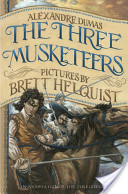 The Three Musketeers
The Three Musketeers War and Peace
War and Peace Notes from the Underground
Notes from the Underground Heidi
Heidi Anne of Green Gables
Anne of Green Gables Uncle Tom’s Cabin
Uncle Tom’s Cabin The Man in the Iron Mask
The Man in the Iron Mask The Prince and the Pauper
The Prince and the Pauper The Jungle
The Jungle The Scarlet Letter
The Scarlet Letter The Lost World
The Lost World Kidnapped
Kidnapped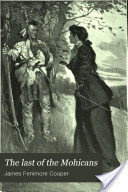 The Last of the Mohicans; A narrative of 1757
The Last of the Mohicans; A narrative of 1757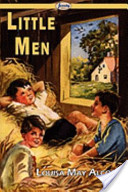 Little Men
Little Men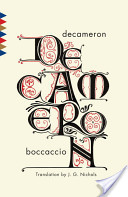 The Decameron of Giovanni Boccaccio
The Decameron of Giovanni Boccaccio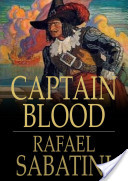 Captain Blood
Captain Blood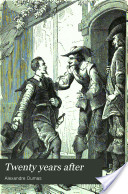 Twenty Years After
Twenty Years After An Occurrence at Owl Creek Bridge
An Occurrence at Owl Creek Bridge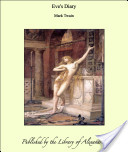 Eve’s Diary, Complete
Eve’s Diary, Complete The Social Cancer: A Complete English Version of Noli Me Tangere
The Social Cancer: A Complete English Version of Noli Me Tangere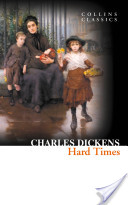 Hard Times
Hard Times Anne of Avonlea
Anne of Avonlea Nostromo, a Tale of the Seaboard
Nostromo, a Tale of the Seaboard Little Lord Fauntleroy
Little Lord Fauntleroy House of the Seven Gables
House of the Seven Gables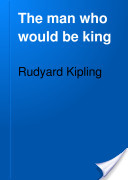 The Man Who Would Be King
The Man Who Would Be King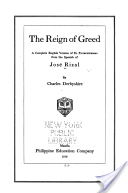 The Reign of Greed
The Reign of Greed The Red Badge of Courage
The Red Badge of Courage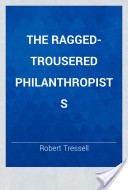 The Ragged Trousered Philanthropists
The Ragged Trousered Philanthropists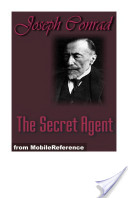 The Secret Agent
The Secret Agent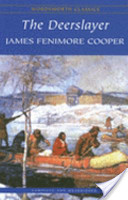 The Deerslayer
The Deerslayer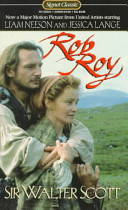 Rob Roy
Rob Roy 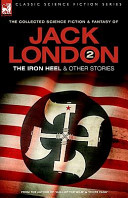 The Iron Heel
The Iron Heel Twice Told Tales
Twice Told Tales The Scarlet Pimpernel
The Scarlet Pimpernel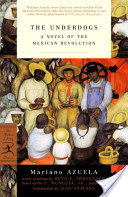 The Underdogs, a Story of the Mexican Revolution
The Underdogs, a Story of the Mexican Revolution A Journal of the Plague Year, written by a citizen who continued all the while in London
A Journal of the Plague Year, written by a citizen who continued all the while in London The Princess of Cleves
The Princess of Cleves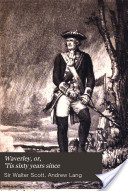 Waverley; Or, ‘Tis Sixty Years Since
Waverley; Or, ‘Tis Sixty Years Since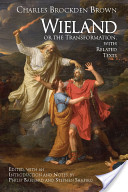 Wieland: or, the Transformation, an American Tale
Wieland: or, the Transformation, an American Tale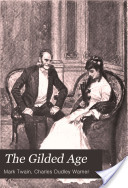 The Gilded Age
The Gilded Age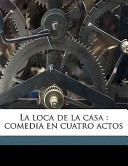 Dona Perfecta
Dona Perfecta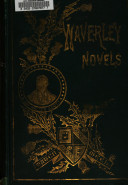 Old Mortality, Complete
Old Mortality, Complete